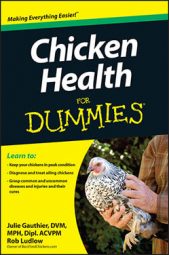Signs of external parasites include:
-
Seeing them crawling on the chickens or in the coop
-
Being bitten by them yourself
-
Noticing chickens with broken, chewed-looking feathers and reddened skin patches
-
Seeing chickens doing a lot of scratching and picking at themselves
-
A drop in egg production
-
Anemia with pale combs and wattles
-
A fluffed-up or sick appearance
Many people today are still willing to let nature call the shots, and they don’t worry about treating their chickens for parasites. If your chickens are acting healthy and producing as you want them to, you may decide not to treat them for parasites.
For those with small flocks that are handled frequently and that are confined at least part of the time, parasites may be unacceptable. Most external parasites that affect birds don’t live on humans, but a few will take a bite out of you if they get on you. You don’t want parasites on you, and you may want your chickens to be as comfortable and healthy as possible. You also may want optimum production. These are good reasons to choose to treat your birds for parasites.
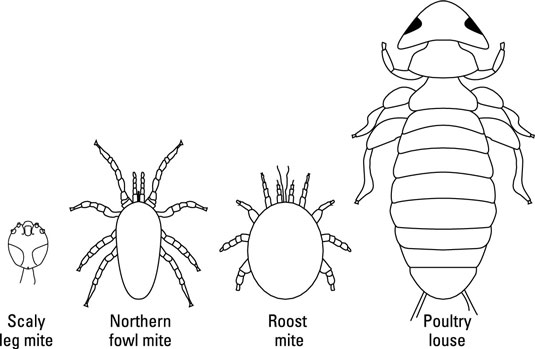
Poultry lice
Poultry lice are wingless, straw-colored insects that feed on dry skin scales, scabs, and feathers. A poultry louse spends its entire life on its bird host; if it falls off the bird, it won’t survive long in the environment — maybe a few days. Lice know what they like, and poultry lice like chickens, not people or pets. If a poultry louse climbs on you, it won’t stay long.Louse infestations are a drag, especially for young chickens, making them jumpy and slow to grow. Fertility and egg production declines for infested adults. The plumage of lousy birds looks patchy and moth-eaten.
Female lice lay their eggs (nits) in clumps on feather shafts. Inspect birds at least twice a month, spreading the feathers in the vent, breast, and thigh areas, looking for nit clumps or pale, scurrying insects. Fall and winter are when most louse infestations are common.
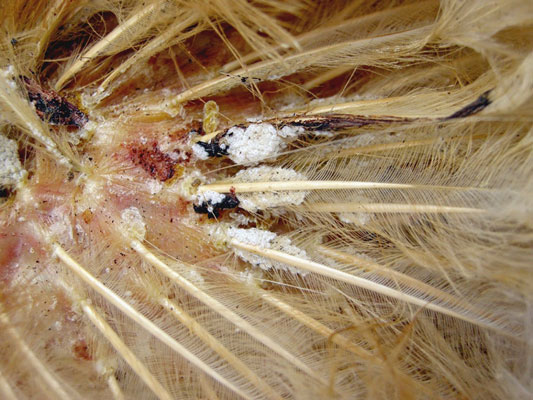
Mites
Mites are tiny relatives of ticks and spiders. A long list of mites infest chickens.Northern fowl mite
The northern fowl mite is a serious pest of poultry, and this mite has also been found scurrying on wild birds, rats, and people. These mites are blood-suckers, and in heavy infestations, they can cause blood loss, stunted growth, decreased egg production, weakness, and even death. They eat anytime, day or night.The mites congregate in the vent area; feathers there may be blackened by mites and mite excrement. If you pick up and handle a bird with northern fowl mites, the mites climbing your arms and hands may creep you out.
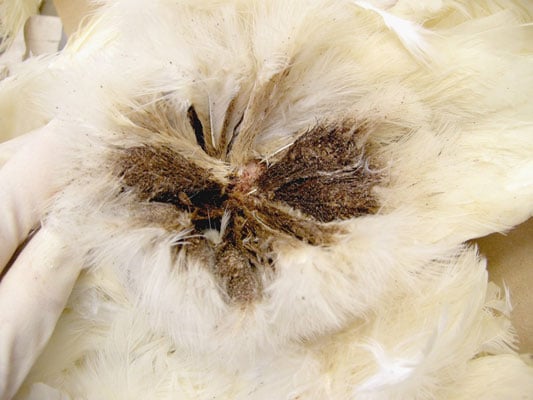
-
Chickens
-
Transport coops
-
People
-
Wild birds
To patrol for a northern fowl mite infestation in your flock, pick up and examine the vent areas of several birds every two weeks.
Roost mite
The roost mite, also known as the red mite or chicken mite, is also a blood-sucker that feeds on poultry and wild birds. The roost mite has a different modus operandi, however; it feeds on chickens only at night and hides in the coop, on roosts, or under piles of droppings during the day.To spot a roost mite infestation, you need to examine birds at night, looking for dark moving specks, or inspect the coop. Roost mites congregate in cracks and crevices inside chicken houses, seen as tiny red or blackish dots clustered together. Another tip-off: Hens may refuse to lay in infested nests.
Roost mites are spread the same way as northern fowl mites: poultry, people, equipment, and wild birds (pigeons, especially). They’re difficult to eradicate from poultry premises, even after the chickens are gone, because roost mites can live for months without eating.Scaly leg mite
Scaly leg mites spend their entire lives in the skin of their bird hosts, burrowing tunnels under the scales of the legs and sometimes into the skin of the combs and wattles. Crusty scabs and lumps appear on the scales of the legs of older birds. Long-term infestations result in deformed toes and limping. Scaly leg mites are transmitted bird to bird and by contact with an infested bird’s environment.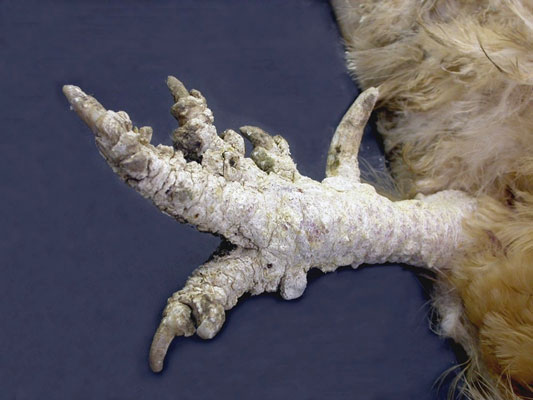
Prevent and treat poultry lice and mites infestations
Lice and mites are born slobs; they like a damp and dirty coop, so general cleanliness can make your coop less hospitable to these unwelcome guests. Here are some additional measures to protect your flock:-
Quarantine all new birds for 30 days before letting them meet your flock. Inspect new birds for external parasites at least twice during the quarantine period and treat them if necessary.
-
Thoroughly clean transport coops after use. You can dislodge hitchhiking pests with a thorough cleaning.
-
Discourage wild birds from hanging out with your flock. To do so, use bird netting, screened coop windows, or scare tactics.
To control lice or mites, treat both the birds and the birds’ environment. Because roost mites spend so much time off the chicken and living in the coop, treating only the birds will fail to eliminate the problem.
If you diagnose poultry lice, northern fowl mite, or roost mites, treat all the birds in the flock at the same time. Isolate any chickens with scaly leg mite from the rest of the flock while they’re being treated.Be patient, and don’t expect to get the situation under control with one shot; repeated treatments are necessary. Lice and mites can develop resistance to pesticides, so vary your method and alternate treatments.
| Pesticide | Effective against | Uses | Forms |
|---|---|---|---|
| Camphor | Scaly leg mite | Chicken’s legs and feet | Ointment |
| Diatomaceous earth (DE) | Lice, northern fowl mite, roost mite | Chicken, coop, dust bath | Powder |
| Garlic juice | Northern fowl mite | Chicken | Spray |
| Ivermectin | Lice, northern fowl mite, roost mite, scaly leg mite | Chicken | By mouth or injection, prescribed by a veterinarian |
| Neem oil | Lice, northern fowl mite, roost mite | Chicken, coop | Spray |
| Petroleum jelly/sulfur mix | Scaly leg mite | Chicken’s legs and feet | Ointment |
| Pyrethrin and permethrin | Lice, northern fowl mite, roost mite | Chicken, coop | Powder, spray, dip |
| Sulfur | Lice, northern fowl mite, roost mite | Chicken, coop, dust bath | Powder, spray |
Or, even easier, let the chickens dust themselves. Build a dust bath box (24 x 24 x 8 inches is a nice size) and fill it with a mix of playground sand and either diatomaceous earth (50:50 sand: DE) or sulfur powder (75:25 sand: sulfur). Sulfur powder, available at garden stores, has especially good residual action against mites and lice.
Fowl ticks and chickens
Ticks cause anemia, weight loss, decreased egg production, and general weakness in chickens. In the South, where this type of tick is most common, it can cause serious illness and even death in chickens. If you suspect ticks, go out and get a chicken several hours after dark and examine the skin closely in a good light. When filled with blood after their nightly meal, they’re large enough to see easily.Ticks are difficult to control. You don’t treat the chicken; you treat its surroundings. This means spraying housing and treating pasture areas and trimming or removing weeds and debris around poultry housing. Ask a vet for recommendations on tick control products.
Chickens and chiggers
Chiggers are nasty little bugs that don’t mind feeding on humans as well as chickens. Chickens get chiggers when they roam grassy areas or come into contact with hay or straw that’s infested with them. Chiggers cause great distress to chickens. They may appear ill and have no interest in eating or drinking. Their feathers appear fluffed up, and they scratch their skin a lot. Young birds sometimes die from heavy infestations.The control of chiggers is the same as with ticks: You treat the environment. In addition, any hay or straw stored close to chickens may need to be moved or destroyed.
Don’t try to eliminate parasites by spraying your housing with old-time remedies like kerosene or fuel oil. These products are environmental pollutants that cause more harm than good, and using them this way is illegal. They also can have toxic effects on your birds because they can be absorbed into your bird’s skin.

